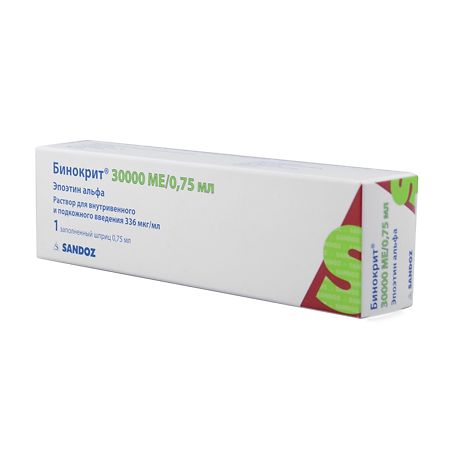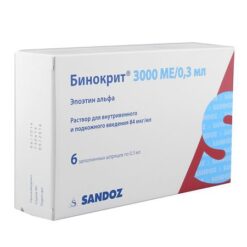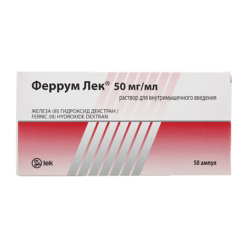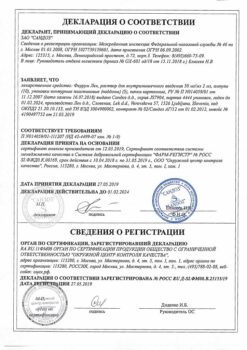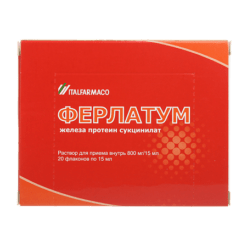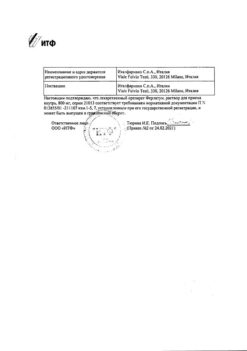No products in the cart.
Binocrit 30000 IU/0.75ml syringe
€220.90 €206.25
Out of stock
(E-mail when Stock is available)
Description
Erythropoietin is a glycoprotein that stimulates erythropoiesis and activates mitosis and maturation of erythrocytes from erythrocyte progenitor cells. The molecular weight of erythropoietin is about 32000-40000 Da. The protein fraction is about 58% of the molecular weight and includes 165 amino acids. Four hydrocarbon chains are linked to the protein by three N-glycoside bonds and one O-glycoside bond. Epoetin alfa, produced using genetically engineered technology, is a purified glycoprotein; its amino acid and carbohydrate composition is identical to that of human erythropoietin excreted from the urine of anemic patients.
Binocrit has the highest possible degree of purification according to modern technological capabilities. In particular, in quantitative analysis of the active ingredient of Binocrit not even trace amounts of cell lines are detected where the drug is produced.
The biological activity of epoetin alfa was confirmed in the experiment in vivo (researches were carried out on healthy rats and rats with anemia as well as on mice with polycythemia). After epoetin alfa injection, the number of erythrocytes, reticulocytes, hemoglobin concentration and 59Fe absorption rate increase. In in vitro studies, incubation with epoetin alfa revealed increased incorporation of 3H-thymidine in erythroid nucleus-containing cells of the spleen (in mouse spleen cell culture). Studies on human bone marrow cell culture showed that epoetin alfa specifically stimulates erythropoiesis and has no effect on leukopoiesis. Cytotoxic effects of erythropoietin on human bone marrow cells were not detected.
Erythropoietin is a growth factor that mainly stimulates the formation of red blood cells. Receptors for erythropoietin can be present on the surface of various tumor cells.
The administration of epoetin alfa is accompanied by an increase in hemoglobin, hematocrit, serum iron, contributes to improved blood supply to tissues and heart function. The most significant effect of epoetin alfa has been noted in anemia caused by chronic renal insufficiency (CKF) and also developed in patients with a number of malignant neoplasms and systemic diseases.
Pharmacokinetics
Intravenous administration
T1/2 epoetin alfa after repeated intravenous administration is about 4 hours in healthy volunteers and about 5 hours in patients with chronic renal failure. In children, T1/2 epoetin alfa is about 6 hours .
Subcutaneous administration
The plasma concentration of epoetin alfa is determined significantly lower by subcutaneous administration than by intravenous administration, the Tmax of epoetin alfa in plasma is about 12-18 hours after administration. Cmax epoetin alfa when administered subcutaneously is only 1/20th of the concentration when administered intravenously. The drug has no ability to cumulate – the concentration of epoetin alfa in blood plasma 24 hours after the first injection is the same as 24 hours after the last injection. When administered subcutaneously, the T1/2 of epoetin alfa is difficult to determine; it is about 24 hours. The bioavailability of epoetin alfa when administered subcutaneously is significantly lower than when administered intravenously and is about 20%.
Indications
Indications
Erythropoietin is a glycoprotein that stimulates erythropoiesis, activates mitosis and maturation of erythrocytes from erythrocyte precursor cells. The molecular weight of erythropoietin is about 32000-40000 Da. The protein fraction is about 58% of the molecular weight and includes 165 amino acids. Four hydrocarbon chains are linked to the protein by three N-glycoside bonds and one O-glycoside bond. Epoetin alfa, produced using genetically engineered technology, is a purified glycoprotein; its amino acid and carbohydrate composition is identical to that of human erythropoietin excreted from the urine of anemic patients.
Binocrit has the highest possible degree of purification according to modern technological capabilities. In particular, in quantitative analysis of the active ingredient of Binocrit, even trace amounts of cell lines are not detected.
The biological activity of epoetin alfa was confirmed in the experiment in vivo (researches were carried out on healthy rats and rats with anemia as well as on mice with polycythemia). After epoetin alfa injection, the number of erythrocytes, reticulocytes, hemoglobin concentration and 59Fe absorption rate increase. In in vitro studies, incubation with epoetin alfa revealed increased incorporation of 3H-thymidine in erythroid nucleus-containing cells of the spleen (in mouse spleen cell culture). Studies on human bone marrow cell culture showed that epoetin alfa specifically stimulates erythropoiesis and has no effect on leukopoiesis. Cytotoxic effects of erythropoietin on human bone marrow cells were not detected.
Erythropoietin is a growth factor that mainly stimulates the formation of red blood cells. Receptors to erythropoietin can be present on the surface of various tumor cells.
Administration of epoetin alfa is accompanied by an increase in hemoglobin, hematocrit, serum iron, contributes to improvement of blood supply to tissues and heart function. The most significant effect of epoetin alfa is noted in anemia caused by chronic renal failure (CKF), as well as developed in patients with a number of malignant neoplasms and systemic diseases.
Pharmacokinetics
Intravenous administration
T1/2 epoetin alfa after repeated intravenous administration is about 4 hours in healthy volunteers and about 5 hours in patients with chronic renal failure. In children, T1/2 epoetin alfa is about 6 hours .
Subcutaneous administration
The plasma concentration of epoetin alfa is determined significantly lower by subcutaneous administration than by intravenous administration, the Tmax of epoetin alfa in plasma is about 12-18 hours after administration. Cmax epoetin alfa when administered subcutaneously is only 1/20th of the concentration when administered intravenously. The drug has no ability to cumulate – the concentration of epoetin alfa in blood plasma 24 hours after the first injection is the same as 24 hours after the last injection. When administered subcutaneously, the T1/2 of epoetin alfa is difficult to determine; it is about 24 hours. The bioavailability of epoetin alfa when administered subcutaneously is significantly lower than when administered intravenously and is about 20%.
Active ingredient
Active ingredient
Composition
Composition
1 ml of solution for intravenous and subcutaneous administration contains:
The active ingredient:
epoetin alfa;
Associates:
Sodium dihydrophosphate dihydrate,
Sodium hydrophosphate dihydrate,
Sodium chloride,
Glycine,
Polysorbate 80,
Hydrochloric acid,
sodium hydroxide,
water for injection.
How to take, the dosage
How to take, the dosage
Intravenously, subcutaneously.
Treatment with Binocrit should be carried out under supervision of a specialist with appropriate qualification and experience in treatment of patients who are indicated for therapy with drugs – stimulants of erythropoiesis.
Doses
Treatment of symptomatic anemia in adults and children with CPN: Binocrit in patients with CPN is administered by IV. Due to the fact that clinical manifestations of anemia and residual effects may vary depending on age, sex and general severity of the disease, individual assessment of each patient is carried out.
The target hemoglobin concentration is 10-12 g/dL (6.2-7.5 mmol/L) in adults and 9.5-11 g/dL (5.9-6.8 mmol/L) in children.
Hemoglobin concentrations above 12 g/dL (7.5 mmol/L) over a prolonged period are not recommended. If the hemoglobin concentration increases more than 2 g/dL (1.25 mmol/L) per month or exceeds 12 g/dL (7.5 mmol/L) for a long time, the dose of Binocrit should be reduced by 25%. If the hemoglobin concentration is more than 13 g/dl (8.1 mmol/l), it is necessary to stop the treatment until hemoglobin decreases to 12 g/dl (7.5 mmol/l) and then resume the therapy with Binocrit, reducing the initial dose by 25%.
Hemoglobin concentrations may be higher or lower than optimal (target) values due to interindividual variability.
The treatment should be prescribed in such a way that the lowest effective dose of Binocrit provides the necessary control of hemoglobin and clinical manifestations of the disease.
Physical iron concentration in plasma should be monitored before and during treatment; if necessary additional iron preparations are prescribed.
Adult patients receiving hemodialysis
Treatment is carried out in two stages.
Correction stage. Binocrit is administered intravenously at a dose of 50 IU/kg three times a week. If necessary, the dose is adjusted gradually over a period of 4 weeks.
The dose is increased or decreased no more than 25 IU/kg 3 times a week.
The maintenance therapy stage. Dose adjustment in order to maintain the necessary level of hemoglobin 10-12 g/dl (6.2-7.5 mmol/l).
The recommended weekly dose of Binocrit is from 75 to 300 IU/kg, administered intravenously 25-100 IU/kg 3 times a week.
In patients with severe anemia (hemoglobin Application in children receiving hemodialysis
Treatment is carried out in two stages.
The correction stage. Binocrit is administered intravenously at a dose of 50 IU/kg 3 times a week. If necessary, the dose is adjusted gradually over a period of 4 weeks. Increase or decrease of the dose – no more than 25 IU/kg 3 times a week.
Maintenance therapy stage. Dose adjustment in order to maintain the required level of hemoglobin 9.5-11 g/dl (5.9-6.8 mmol/l).
In most cases in children with body weight less than 30 kg, higher maintenance doses should be used than in children with higher body weight and adults.
Binocrit is administered subcutaneously.
The recommended dose of Binocrit is 600 IU/kg once a week during the 3 weeks prior to surgery (21, 14 and 7 days before surgery) and on the day of surgery. If the preoperative period is shorter than 3 weeks, Binocrit should be administered daily at a dose of 300 IU/kg for 10 consecutive days, before surgery, on the day of surgery, and for 4 days after surgery. If preoperative Hb concentration is 15 g/dL (9.38 mmol/L) or higher, the drug should be discontinued. It should be ensured that patients have no iron deficiency before starting treatment with Binocrit.
All patients treated with Binocrit should receive adequate divalent iron (200 mg/day orally) for the duration of therapy.
Interaction
Interaction
Special Instructions
Special Instructions
BP should be checked and closely monitored in all patients when Binocrit is prescribed. Caution should be exercised when using epoetin alfa in patients with hypertension if they are not receiving the necessary treatment, the prescribed treatment is inadequate, or the hypertension is poorly controlled. In this case, it may be necessary to initiate or intensify antihypertensive therapy that has already been used. If BP cannot be normalized, treatment with epoetin alfa should be discontinued. Binocrit is used with caution in the presence of epilepsy and chronic hepatic insufficiency.
CPN patients and cancer patients should have their hemoglobin levels monitored regularly until stable values are achieved and periodically thereafter.
Close monitoring of hemoglobin levels is mandatory for all patients due to increased potential risk of thromboembolic complications and an increase in fatal cases where patients were treated at hemoglobin levels greater than the established norm for the indication.
Moderate dose-dependent increases in platelet counts within the normal range may be observed during treatment with Binocrit. This amount decreases again with continuation of therapy. During the first 8 weeks after the beginning of the therapy it is recommended to control the platelet count regularly.
Before the beginning of the therapy all other causes of anemia (iron deficiency, hemolysis, blood loss, vitamin B12 or folic acid deficiency) should be excluded. In most cases the level of ferritin in blood serum decreases with the simultaneous increase of hematocrit.
All mentioned additional factors of anemia should be also considered while increasing the dosage of the preparation Binocrit in patients with neoplasms.
All blood values should be closely monitored during the perioperative period.
PCCA
After several months or years of treatment with subcutaneous erythropoietin injections, cases of antibody-mediated PKKA have been very rarely observed. If patients have a dramatic decrease in the efficacy of therapy due to a decrease in hemoglobin concentration (1-2 g/dL per month) with an increased need for hemotransfusions, the reticulocyte count should be checked and the typical reasons for a lack of response to the drug (such as iron, folic acid or vitamin B12 deficiency, aluminum intoxication, infection or inflammation, bleeding or hemolysis) examined.
If anemia-mediated reticulocyte counts (e.g., reticulocytic index) are low (If PKKA mediated through erythropoietin antibodies is suspected, therapy with Binocrit should be stopped immediately. Any other erythropoietin therapy should not be prescribed because of the risk of cross-reactivity. If indicated, patients may be given necessary therapy, such as hemotransfusions.
In the event of a paradoxical decrease in hemoglobin concentration and development of severe anemia due to low reticulocyte counts, treatment with epoetin should be stopped immediately and an erythropoietin antibody test performed. There is evidence of such manifestations in patients with hepatitis C treated with interferon and ribavirin simultaneously with epoetin. Epoetin is not indicated for treatment of anemia caused by hepatitis C.
Patients with CKD
The data about immunogenicity by subcutaneous administration of Binocrit in patients with risk of PCKA mediated by antibodies, for example in patients with renal anemia, are limited. As a consequence, patients with renal anemia should be given the drug intravenously.
In order to minimize the risks of increased hypertension for patients with CKD, the rate of increase in hemoglobin should be approximately 1 g/dL (0.62 mmol/L) per month and should not exceed 2 g/dL (1.25 mmol/L) per month.
In patients with CKD, hemoglobin concentrations during maintenance treatment should not exceed the HGH recommended in the Administration and Dose section. Results of clinical studies have shown an increased risk of fatal outcomes and severe cardiovascular events when administering erythropoiesis-stimulating agents to increase hemoglobin concentration above 12 g/dL (7.5 mmol/L).
In clinical studies in controlled settings, no significant benefit has been found associated with the use of epoetins against the background of increasing hemoglobin concentration above the level necessary to control the symptoms of anemia and prevent hemotransfusions. Cases of shunt thrombosis have been reported in patients on hemodialysis, particularly when prone to hypotension or due to the formation of arteriovenous fistulas (e.g. stenosis, aneurysm, etc.). Early shunt correction and thrombosis prophylaxis, e.g. with acetylsalicylic acid, is recommended in these patients.
In isolated cases, hyperkalemia has been observed. Treatment of anemia may result in increased appetite and increased need for potassium and protein. The dialysis regimen should be periodically adjusted to maintain adequate urea, creatinine, and potassium levels. Serum electrolytes should be checked in patients with CKD. If elevated (or increasing) serum potassium levels are detected, the feasibility of withdrawing epoetin alfa treatment until potassium levels normalize should be evaluated.
At the time of treatment with epoetin alfa, an increase in heparin dose is often required during hemodialysis due to an increase in hematocrit number. If heparinization cannot be maximally effective, the dialysis regimen may need to be discontinued.
Treatment of anemia with epoetin alfa in adult patients with renal failure who are not yet on dialysis has not been reported to cause progression of renal failure.
Adult cancer patients with symptomatic anemia undergoing chemotherapy
In some clinical situations, blood transfusions should be used to treat anemia in patients with cancer. The decision to administer recombinant erythropoietins should be made taking into account the balance of benefits and possible risks for each patient individually and the specific clinical situation. The following factors should be considered: type and stage of neoplasm; degree of anemia; life expectancy; environment in which the patient will be treated; patient’s wishes.
When evaluating the appropriateness of epoetin alfa therapy (risk of blood transfusion for the patient) in cancer patients receiving chemotherapy, a delay of 2-3 weeks after epoetin alfa administration before erythropoietin stimulation should be considered.
In order to minimize the risk of thrombotic events, it is necessary to ensure that the hemoglobin level and its rate of increase do not exceed the acceptable values.
Due to the increasing incidence of venous thrombotic complications in cancer patients treated with erythropoietin-stimulating drugs, this risk and benefit of epoetin alfa treatment should be carefully evaluated, especially in cancer patients at increased risk of venous thrombotic complications, such as those who are obese or have a family history of venous thrombotic disease (including deep venous thrombotic disease).
Adult patients participating in an autologous blood collection program prior to surgery
All special precautions related to autologous blood collection programs must be observed, especially for regular blood transfusions.
Patients undergoing elective orthopedic surgery
For patients undergoing elective orthopedic surgery, the cause of the anemia should be established and, if possible, the anemia should be treated before starting therapy with epoetin alfa. These patients may be at risk for thrombotic events, which must be carefully evaluated when prescribing treatment for this group of patients.
Patients undergoing elective orthopedic surgery should receive adequate antithrombotic prophylaxis due to the risk of venous thrombotic complications in surgical patients, particularly those with cardiovascular disease. In addition, special precautions should be taken in patients with a predisposition to develop deep vein thrombosis of the extremities. Patients with an initial hemoglobin level of >13 g/dL (>8.1 mmol/L) have an increased risk of postoperative thrombotic/venous complications. As a consequence, the drug should not be administered to patients with an initial hemoglobin level of >13 g/dl (>8.1 mmol/l).
Excipients
This medication contains less than 1 mmol of sodium (23 mg) in one pre-filled syringe, i.e. it actually contains no sodium.
Synopsis
Synopsis
Contraindications
Contraindications
With caution: malignant tumors, epilepsy syndrome (including history), chronic renal and hepatic insufficiency, thrombocytosis, thrombosis (history), acute blood loss, sickle cell anemia, hemolytic anemia, iron-, B12- or folate-deficient states.
Side effects
Side effects
Blood and lymphatic system disorders: infrequent – thrombocythemia (in patients with malignancies); frequency unknown – antibody-mediated PKKA1, thrombocythemia (in patients with CKD).
Immune system disorders: frequency unknown – anaphylactic reaction, hypersensitivity.
Nervous system disorders: very common – headache (in patients with malignancies); common – seizures (in patients with CKD), headache (in patients with CKD); infrequent – hemorrhagic stroke2, seizures (in patients with malignancies); frequency unknown – stroke2, hypertensive encephalopathy, transient ischemic attacks.
An organ of vision: frequency unknown – retinal thrombosis.
Particular system disorders: common – lower extremity deep vein thrombosis (in patients with malignant tumors); increased BP; common unknown – lower extremity deep vein thrombosis (in patients with CKD), arterial thrombosis, hypertensive crisis.
Respiratory system disorders: frequent – pulmonary embolism2 (in patients with malignancies); frequency unknown – pulmonary embolism2 (in patients with CKD).
Gastrointestinal disorders: very common – nausea; common – diarrhea (in patients with cancer), vomiting; infrequent – diarrhea (in patients with CKD).
Skin and its appendages: often – skin rash; frequency unknown – angioedema, urticaria.
Muscular system: very common – arthralgia (in CPN); common – arthralgia (in patients with malignancies); infrequent – myalgia (in patients with malignancies); common unknown – myalgia (in CPN).
Congenital, familial/genetic disorders: frequency unknown – porphyria.
Body in general: very common – hyperthermia (in patients with malignancies); flu-like condition (in COPD); common – flu-like condition (in patients with malignancies); frequency unknown – drug inefficacy, peripheral edema, hyperthermia (in COPD), injection site reactions.
Laboratory findings: frequency unknown – antibodies to erythropoietin1.
Others: common – dialysis equipment shunt thrombosis (in patients with CKD).
1 Frequency of manifestations cannot be estimated from clinical studies.
2 Including fatal cases.
Overdose
Overdose
Similarities
Similarities
Additional information
| Shelf life | 2 years |
|---|---|
| Conditions of storage | At 2-8 °C (do not freeze). |
| Manufacturer | I.D.T. Biology GmbH, Germany |
| Medication form | solution for injections and infusions |
| Brand | I.D.T. Biology GmbH |
Other forms…
Related products
Buy Binocrit 30000 IU/0.75ml syringe with delivery to USA, UK, Europe and over 120 other countries.

